Employee Motivation: Increasing Business at Waitrose Ltd Analysis
VerifiedAdded on 2023/06/17
|9
|2376
|221
Report
AI Summary
This report investigates the significance of employee motivation in enhancing business and workforce performance, focusing on Waitrose Ltd as a case study. It aims to identify the methods Waitrose Ltd uses to motivate its employees, determine the importance of motivated employees in improving business outcomes, and examine the challenges faced in this process. The research employs a deductive approach and a survey strategy, utilizing quantitative research methodology with both primary (questionnaires) and secondary data collection methods. Probability sampling is used to select 25 managers from Waitrose Ltd. The study also addresses ethical considerations to ensure participant anonymity and confidentiality. The expected outcomes include demonstrating the crucial role of motivation in the company's success and the effectiveness of primary and secondary data sources in achieving research objectives. The report acknowledges limitations such as time constraints and resource availability.

BSc (Hons) Business Management (Top-up)
BMP6001 DISSERTATION
Assessment 1 – Research Proposal
Importance of employee motivation in increasing business as
well as workforce performance within a workplace”: A study on
Waitrose Ltd
Submitted by:
Name:
ID:
1
BMP6001 DISSERTATION
Assessment 1 – Research Proposal
Importance of employee motivation in increasing business as
well as workforce performance within a workplace”: A study on
Waitrose Ltd
Submitted by:
Name:
ID:
1
Paraphrase This Document
Need a fresh take? Get an instant paraphrase of this document with our AI Paraphraser
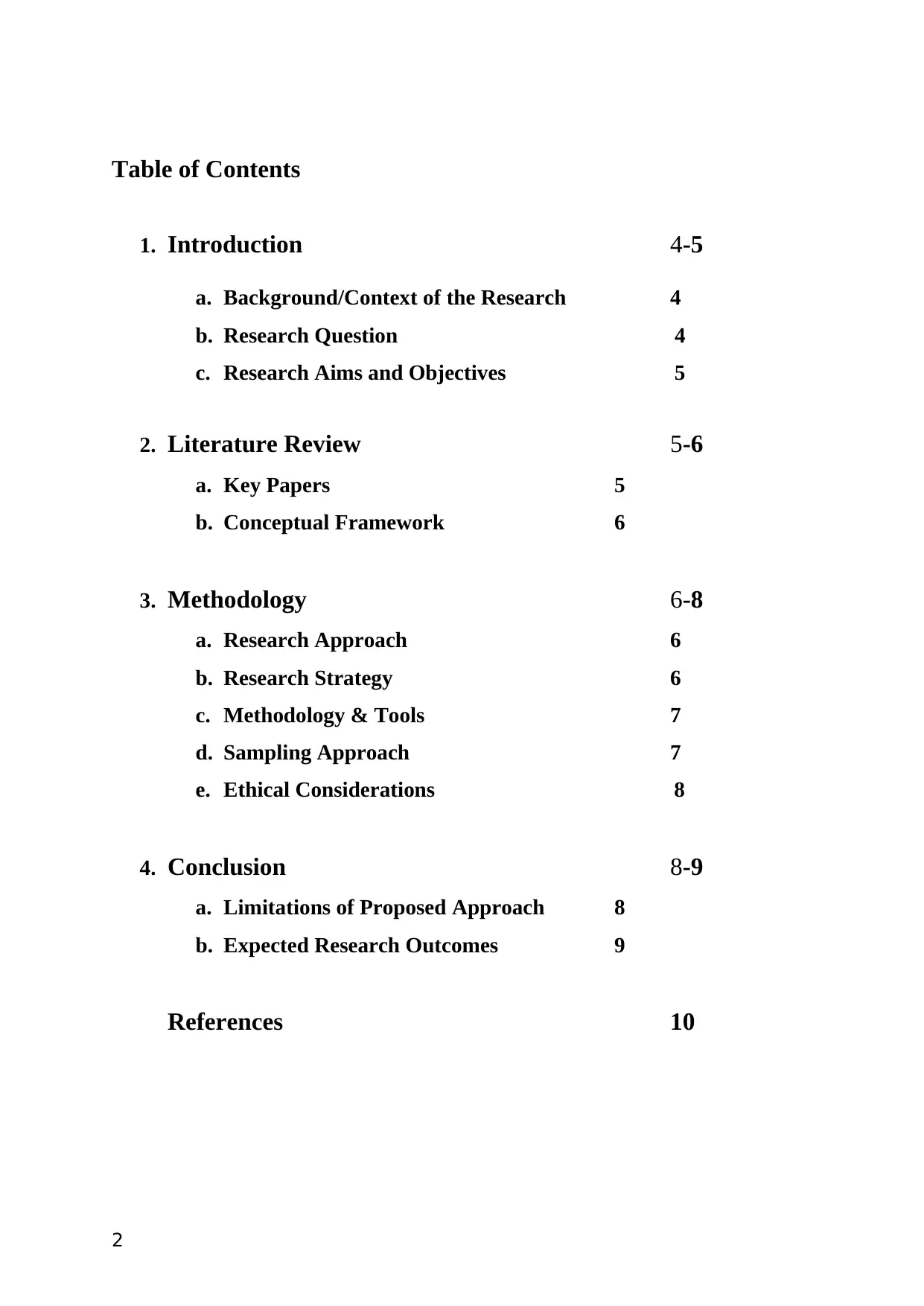
Table of Contents
1. Introduction 4-5
a. Background/Context of the Research 4
b. Research Question 4
c. Research Aims and Objectives 5
2. Literature Review 5-6
a. Key Papers 5
b. Conceptual Framework 6
3. Methodology 6-8
a. Research Approach 6
b. Research Strategy 6
c. Methodology & Tools 7
d. Sampling Approach 7
e. Ethical Considerations 8
4. Conclusion 8-9
a. Limitations of Proposed Approach 8
b. Expected Research Outcomes 9
References 10
2
1. Introduction 4-5
a. Background/Context of the Research 4
b. Research Question 4
c. Research Aims and Objectives 5
2. Literature Review 5-6
a. Key Papers 5
b. Conceptual Framework 6
3. Methodology 6-8
a. Research Approach 6
b. Research Strategy 6
c. Methodology & Tools 7
d. Sampling Approach 7
e. Ethical Considerations 8
4. Conclusion 8-9
a. Limitations of Proposed Approach 8
b. Expected Research Outcomes 9
References 10
2
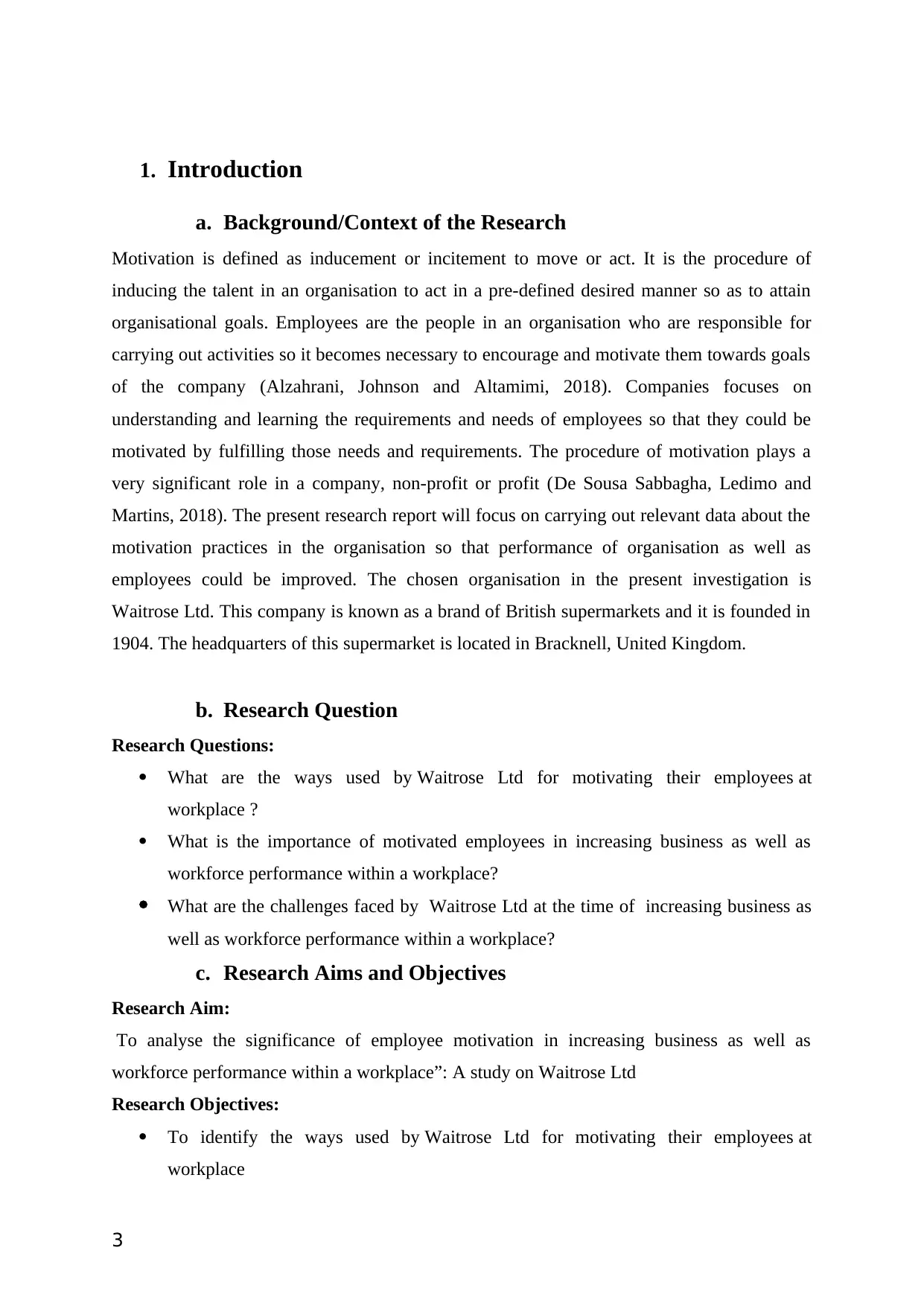
1. Introduction
a. Background/Context of the Research
Motivation is defined as inducement or incitement to move or act. It is the procedure of
inducing the talent in an organisation to act in a pre-defined desired manner so as to attain
organisational goals. Employees are the people in an organisation who are responsible for
carrying out activities so it becomes necessary to encourage and motivate them towards goals
of the company (Alzahrani, Johnson and Altamimi, 2018). Companies focuses on
understanding and learning the requirements and needs of employees so that they could be
motivated by fulfilling those needs and requirements. The procedure of motivation plays a
very significant role in a company, non-profit or profit (De Sousa Sabbagha, Ledimo and
Martins, 2018). The present research report will focus on carrying out relevant data about the
motivation practices in the organisation so that performance of organisation as well as
employees could be improved. The chosen organisation in the present investigation is
Waitrose Ltd. This company is known as a brand of British supermarkets and it is founded in
1904. The headquarters of this supermarket is located in Bracknell, United Kingdom.
b. Research Question
Research Questions:
What are the ways used by Waitrose Ltd for motivating their employees at
workplace ?
What is the importance of motivated employees in increasing business as well as
workforce performance within a workplace?
What are the challenges faced by Waitrose Ltd at the time of increasing business as
well as workforce performance within a workplace?
c. Research Aims and Objectives
Research Aim:
To analyse the significance of employee motivation in increasing business as well as
workforce performance within a workplace”: A study on Waitrose Ltd
Research Objectives:
To identify the ways used by Waitrose Ltd for motivating their employees at
workplace
3
a. Background/Context of the Research
Motivation is defined as inducement or incitement to move or act. It is the procedure of
inducing the talent in an organisation to act in a pre-defined desired manner so as to attain
organisational goals. Employees are the people in an organisation who are responsible for
carrying out activities so it becomes necessary to encourage and motivate them towards goals
of the company (Alzahrani, Johnson and Altamimi, 2018). Companies focuses on
understanding and learning the requirements and needs of employees so that they could be
motivated by fulfilling those needs and requirements. The procedure of motivation plays a
very significant role in a company, non-profit or profit (De Sousa Sabbagha, Ledimo and
Martins, 2018). The present research report will focus on carrying out relevant data about the
motivation practices in the organisation so that performance of organisation as well as
employees could be improved. The chosen organisation in the present investigation is
Waitrose Ltd. This company is known as a brand of British supermarkets and it is founded in
1904. The headquarters of this supermarket is located in Bracknell, United Kingdom.
b. Research Question
Research Questions:
What are the ways used by Waitrose Ltd for motivating their employees at
workplace ?
What is the importance of motivated employees in increasing business as well as
workforce performance within a workplace?
What are the challenges faced by Waitrose Ltd at the time of increasing business as
well as workforce performance within a workplace?
c. Research Aims and Objectives
Research Aim:
To analyse the significance of employee motivation in increasing business as well as
workforce performance within a workplace”: A study on Waitrose Ltd
Research Objectives:
To identify the ways used by Waitrose Ltd for motivating their employees at
workplace
3
⊘ This is a preview!⊘
Do you want full access?
Subscribe today to unlock all pages.

Trusted by 1+ million students worldwide
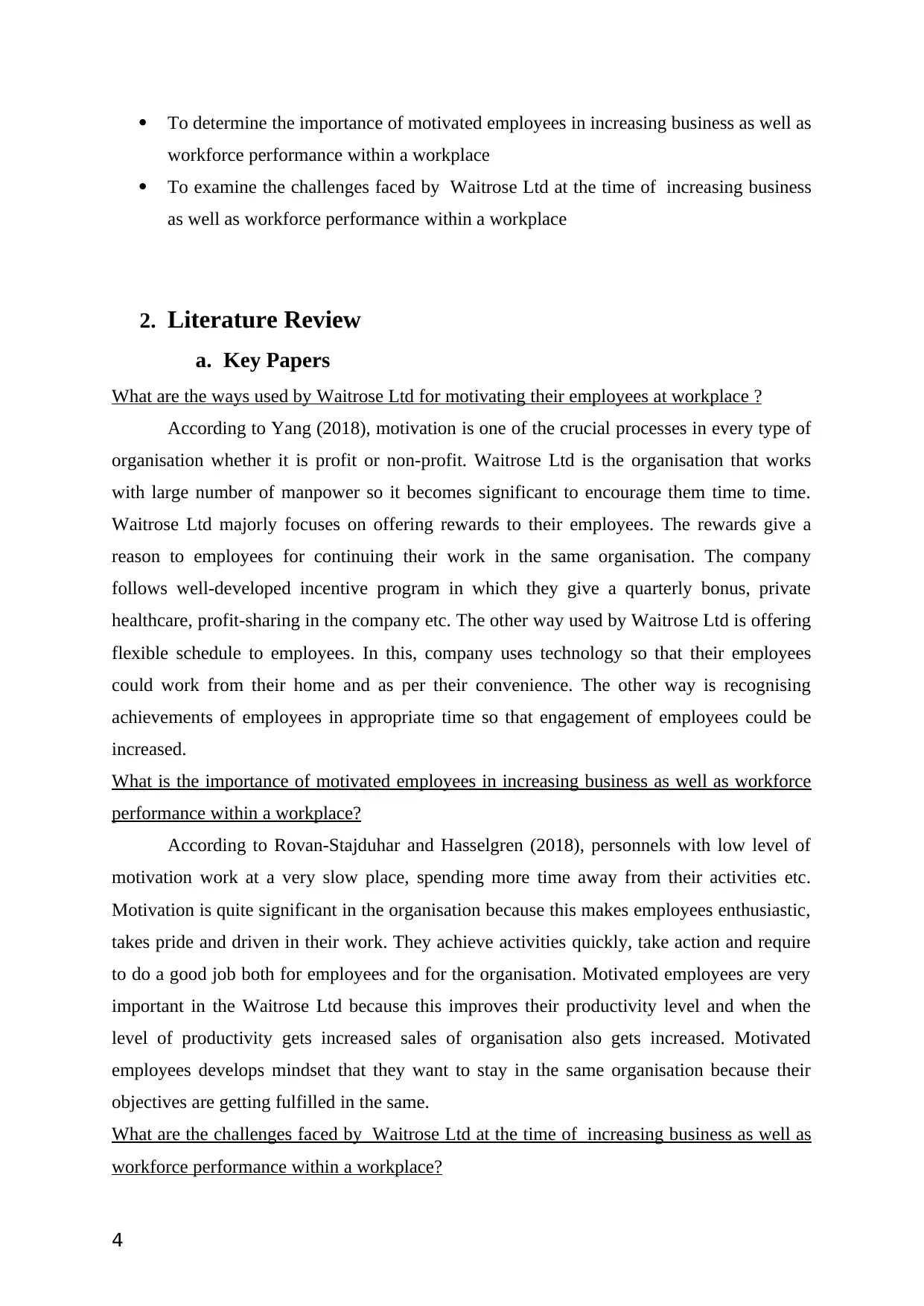
To determine the importance of motivated employees in increasing business as well as
workforce performance within a workplace
To examine the challenges faced by Waitrose Ltd at the time of increasing business
as well as workforce performance within a workplace
2. Literature Review
a. Key Papers
What are the ways used by Waitrose Ltd for motivating their employees at workplace ?
According to Yang (2018), motivation is one of the crucial processes in every type of
organisation whether it is profit or non-profit. Waitrose Ltd is the organisation that works
with large number of manpower so it becomes significant to encourage them time to time.
Waitrose Ltd majorly focuses on offering rewards to their employees. The rewards give a
reason to employees for continuing their work in the same organisation. The company
follows well-developed incentive program in which they give a quarterly bonus, private
healthcare, profit-sharing in the company etc. The other way used by Waitrose Ltd is offering
flexible schedule to employees. In this, company uses technology so that their employees
could work from their home and as per their convenience. The other way is recognising
achievements of employees in appropriate time so that engagement of employees could be
increased.
What is the importance of motivated employees in increasing business as well as workforce
performance within a workplace?
According to Rovan-Stajduhar and Hasselgren (2018), personnels with low level of
motivation work at a very slow place, spending more time away from their activities etc.
Motivation is quite significant in the organisation because this makes employees enthusiastic,
takes pride and driven in their work. They achieve activities quickly, take action and require
to do a good job both for employees and for the organisation. Motivated employees are very
important in the Waitrose Ltd because this improves their productivity level and when the
level of productivity gets increased sales of organisation also gets increased. Motivated
employees develops mindset that they want to stay in the same organisation because their
objectives are getting fulfilled in the same.
What are the challenges faced by Waitrose Ltd at the time of increasing business as well as
workforce performance within a workplace?
4
workforce performance within a workplace
To examine the challenges faced by Waitrose Ltd at the time of increasing business
as well as workforce performance within a workplace
2. Literature Review
a. Key Papers
What are the ways used by Waitrose Ltd for motivating their employees at workplace ?
According to Yang (2018), motivation is one of the crucial processes in every type of
organisation whether it is profit or non-profit. Waitrose Ltd is the organisation that works
with large number of manpower so it becomes significant to encourage them time to time.
Waitrose Ltd majorly focuses on offering rewards to their employees. The rewards give a
reason to employees for continuing their work in the same organisation. The company
follows well-developed incentive program in which they give a quarterly bonus, private
healthcare, profit-sharing in the company etc. The other way used by Waitrose Ltd is offering
flexible schedule to employees. In this, company uses technology so that their employees
could work from their home and as per their convenience. The other way is recognising
achievements of employees in appropriate time so that engagement of employees could be
increased.
What is the importance of motivated employees in increasing business as well as workforce
performance within a workplace?
According to Rovan-Stajduhar and Hasselgren (2018), personnels with low level of
motivation work at a very slow place, spending more time away from their activities etc.
Motivation is quite significant in the organisation because this makes employees enthusiastic,
takes pride and driven in their work. They achieve activities quickly, take action and require
to do a good job both for employees and for the organisation. Motivated employees are very
important in the Waitrose Ltd because this improves their productivity level and when the
level of productivity gets increased sales of organisation also gets increased. Motivated
employees develops mindset that they want to stay in the same organisation because their
objectives are getting fulfilled in the same.
What are the challenges faced by Waitrose Ltd at the time of increasing business as well as
workforce performance within a workplace?
4
Paraphrase This Document
Need a fresh take? Get an instant paraphrase of this document with our AI Paraphraser
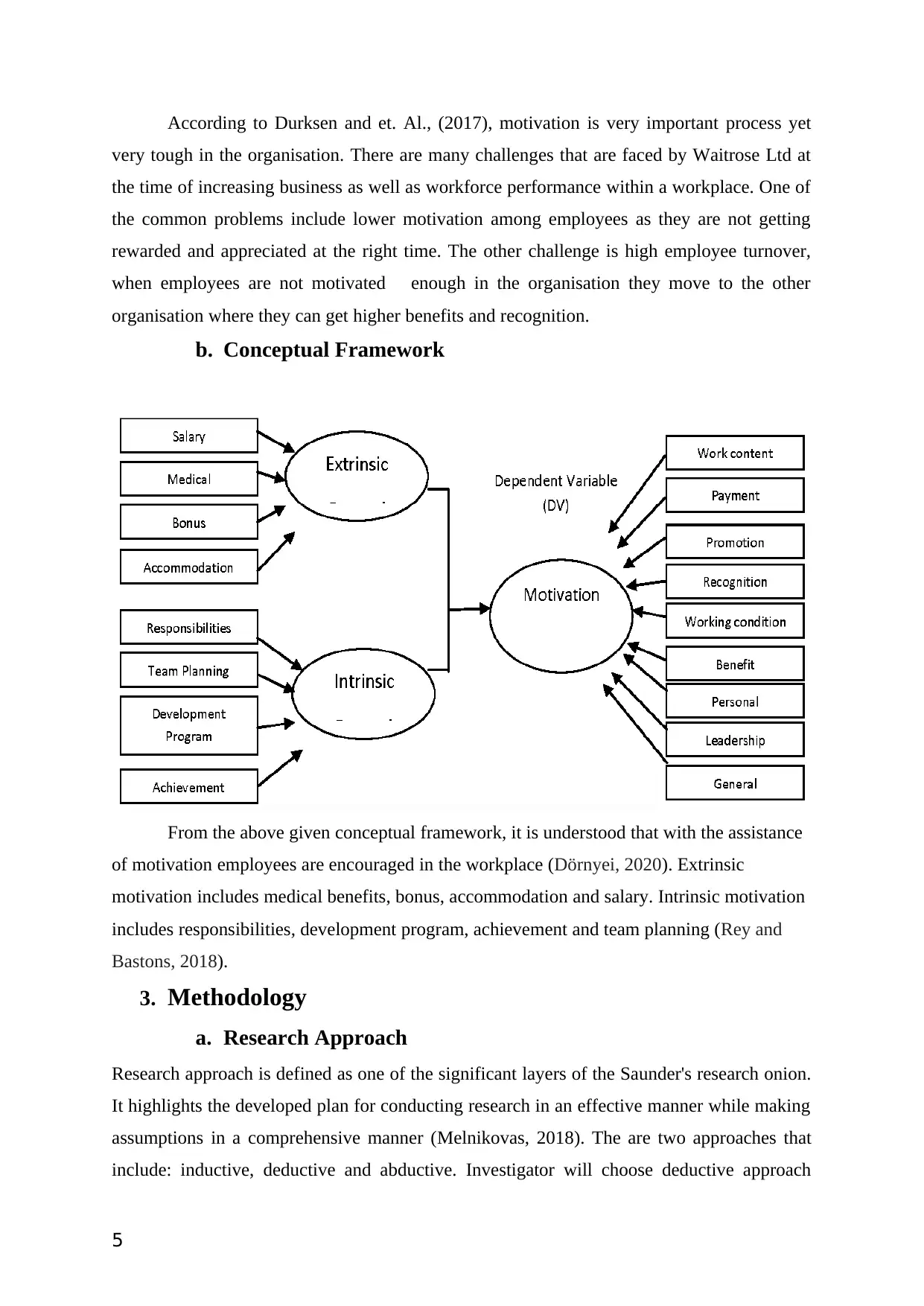
According to Durksen and et. Al., (2017), motivation is very important process yet
very tough in the organisation. There are many challenges that are faced by Waitrose Ltd at
the time of increasing business as well as workforce performance within a workplace. One of
the common problems include lower motivation among employees as they are not getting
rewarded and appreciated at the right time. The other challenge is high employee turnover,
when employees are not motivated enough in the organisation they move to the other
organisation where they can get higher benefits and recognition.
b. Conceptual Framework
From the above given conceptual framework, it is understood that with the assistance
of motivation employees are encouraged in the workplace (Dörnyei, 2020). Extrinsic
motivation includes medical benefits, bonus, accommodation and salary. Intrinsic motivation
includes responsibilities, development program, achievement and team planning (Rey and
Bastons, 2018).
3. Methodology
a. Research Approach
Research approach is defined as one of the significant layers of the Saunder's research onion.
It highlights the developed plan for conducting research in an effective manner while making
assumptions in a comprehensive manner (Melnikovas, 2018). The are two approaches that
include: inductive, deductive and abductive. Investigator will choose deductive approach
5
very tough in the organisation. There are many challenges that are faced by Waitrose Ltd at
the time of increasing business as well as workforce performance within a workplace. One of
the common problems include lower motivation among employees as they are not getting
rewarded and appreciated at the right time. The other challenge is high employee turnover,
when employees are not motivated enough in the organisation they move to the other
organisation where they can get higher benefits and recognition.
b. Conceptual Framework
From the above given conceptual framework, it is understood that with the assistance
of motivation employees are encouraged in the workplace (Dörnyei, 2020). Extrinsic
motivation includes medical benefits, bonus, accommodation and salary. Intrinsic motivation
includes responsibilities, development program, achievement and team planning (Rey and
Bastons, 2018).
3. Methodology
a. Research Approach
Research approach is defined as one of the significant layers of the Saunder's research onion.
It highlights the developed plan for conducting research in an effective manner while making
assumptions in a comprehensive manner (Melnikovas, 2018). The are two approaches that
include: inductive, deductive and abductive. Investigator will choose deductive approach
5
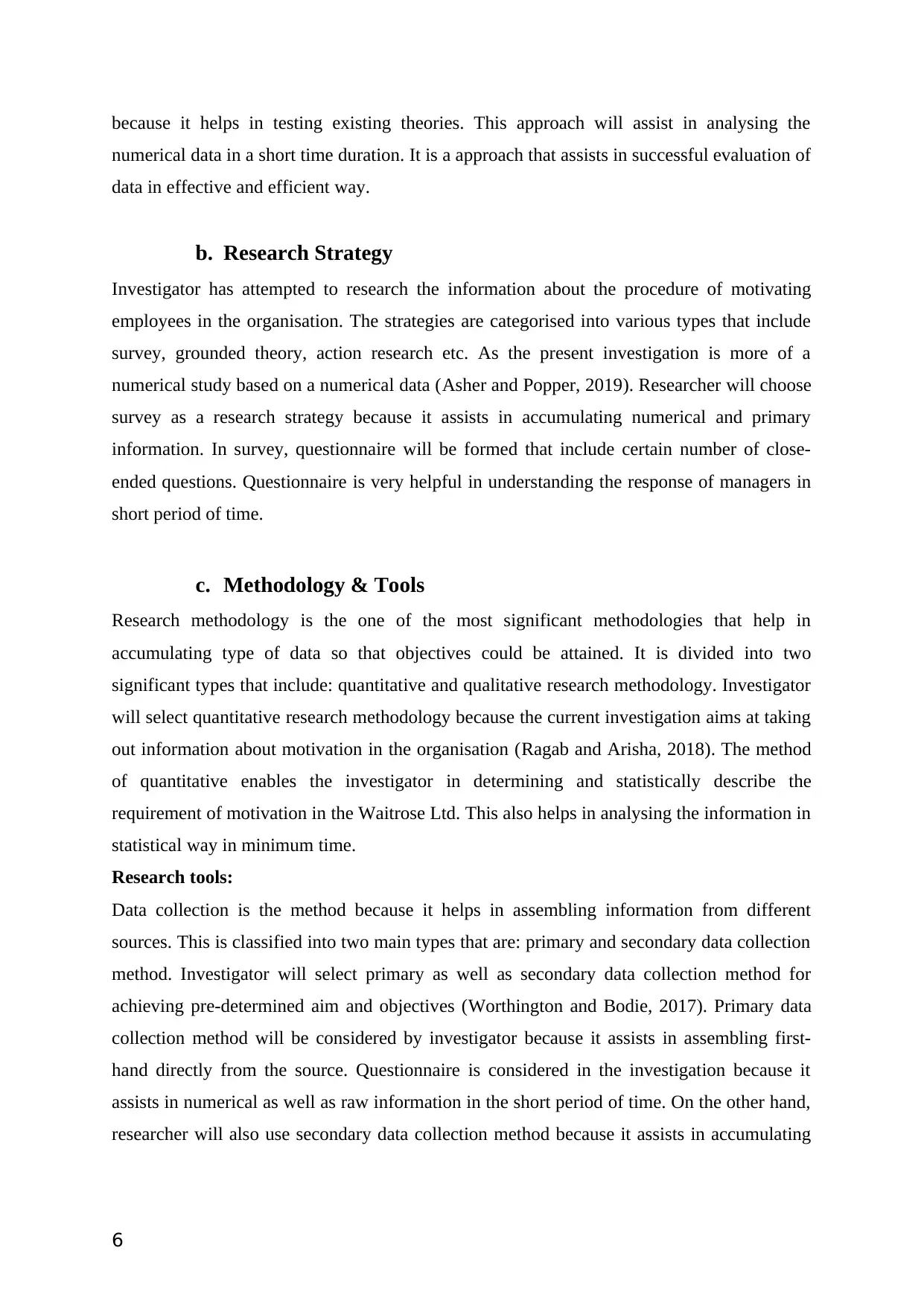
because it helps in testing existing theories. This approach will assist in analysing the
numerical data in a short time duration. It is a approach that assists in successful evaluation of
data in effective and efficient way.
b. Research Strategy
Investigator has attempted to research the information about the procedure of motivating
employees in the organisation. The strategies are categorised into various types that include
survey, grounded theory, action research etc. As the present investigation is more of a
numerical study based on a numerical data (Asher and Popper, 2019). Researcher will choose
survey as a research strategy because it assists in accumulating numerical and primary
information. In survey, questionnaire will be formed that include certain number of close-
ended questions. Questionnaire is very helpful in understanding the response of managers in
short period of time.
c. Methodology & Tools
Research methodology is the one of the most significant methodologies that help in
accumulating type of data so that objectives could be attained. It is divided into two
significant types that include: quantitative and qualitative research methodology. Investigator
will select quantitative research methodology because the current investigation aims at taking
out information about motivation in the organisation (Ragab and Arisha, 2018). The method
of quantitative enables the investigator in determining and statistically describe the
requirement of motivation in the Waitrose Ltd. This also helps in analysing the information in
statistical way in minimum time.
Research tools:
Data collection is the method because it helps in assembling information from different
sources. This is classified into two main types that are: primary and secondary data collection
method. Investigator will select primary as well as secondary data collection method for
achieving pre-determined aim and objectives (Worthington and Bodie, 2017). Primary data
collection method will be considered by investigator because it assists in assembling first-
hand directly from the source. Questionnaire is considered in the investigation because it
assists in numerical as well as raw information in the short period of time. On the other hand,
researcher will also use secondary data collection method because it assists in accumulating
6
numerical data in a short time duration. It is a approach that assists in successful evaluation of
data in effective and efficient way.
b. Research Strategy
Investigator has attempted to research the information about the procedure of motivating
employees in the organisation. The strategies are categorised into various types that include
survey, grounded theory, action research etc. As the present investigation is more of a
numerical study based on a numerical data (Asher and Popper, 2019). Researcher will choose
survey as a research strategy because it assists in accumulating numerical and primary
information. In survey, questionnaire will be formed that include certain number of close-
ended questions. Questionnaire is very helpful in understanding the response of managers in
short period of time.
c. Methodology & Tools
Research methodology is the one of the most significant methodologies that help in
accumulating type of data so that objectives could be attained. It is divided into two
significant types that include: quantitative and qualitative research methodology. Investigator
will select quantitative research methodology because the current investigation aims at taking
out information about motivation in the organisation (Ragab and Arisha, 2018). The method
of quantitative enables the investigator in determining and statistically describe the
requirement of motivation in the Waitrose Ltd. This also helps in analysing the information in
statistical way in minimum time.
Research tools:
Data collection is the method because it helps in assembling information from different
sources. This is classified into two main types that are: primary and secondary data collection
method. Investigator will select primary as well as secondary data collection method for
achieving pre-determined aim and objectives (Worthington and Bodie, 2017). Primary data
collection method will be considered by investigator because it assists in assembling first-
hand directly from the source. Questionnaire is considered in the investigation because it
assists in numerical as well as raw information in the short period of time. On the other hand,
researcher will also use secondary data collection method because it assists in accumulating
6
⊘ This is a preview!⊘
Do you want full access?
Subscribe today to unlock all pages.

Trusted by 1+ million students worldwide
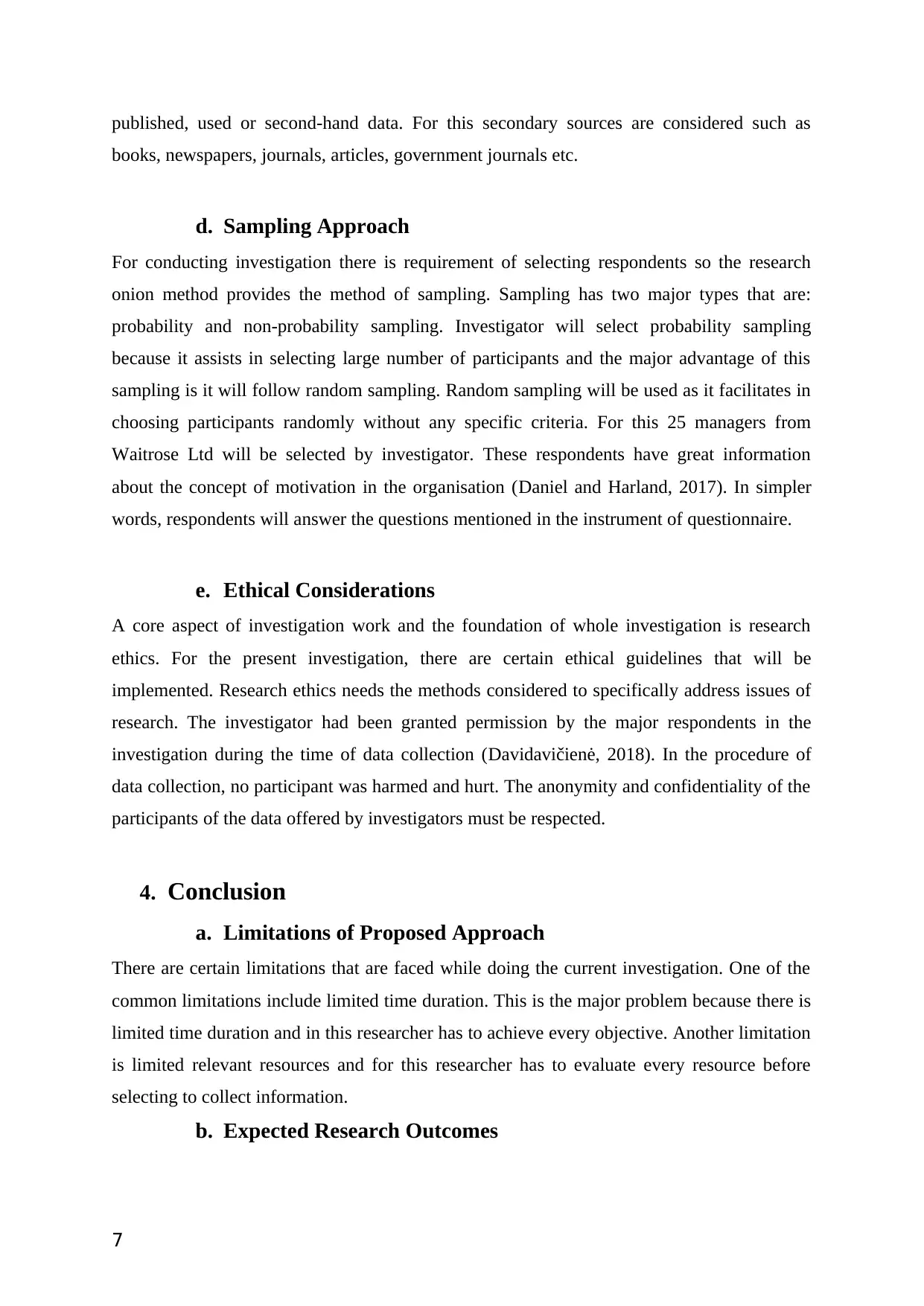
published, used or second-hand data. For this secondary sources are considered such as
books, newspapers, journals, articles, government journals etc.
d. Sampling Approach
For conducting investigation there is requirement of selecting respondents so the research
onion method provides the method of sampling. Sampling has two major types that are:
probability and non-probability sampling. Investigator will select probability sampling
because it assists in selecting large number of participants and the major advantage of this
sampling is it will follow random sampling. Random sampling will be used as it facilitates in
choosing participants randomly without any specific criteria. For this 25 managers from
Waitrose Ltd will be selected by investigator. These respondents have great information
about the concept of motivation in the organisation (Daniel and Harland, 2017). In simpler
words, respondents will answer the questions mentioned in the instrument of questionnaire.
e. Ethical Considerations
A core aspect of investigation work and the foundation of whole investigation is research
ethics. For the present investigation, there are certain ethical guidelines that will be
implemented. Research ethics needs the methods considered to specifically address issues of
research. The investigator had been granted permission by the major respondents in the
investigation during the time of data collection (Davidavičienė, 2018). In the procedure of
data collection, no participant was harmed and hurt. The anonymity and confidentiality of the
participants of the data offered by investigators must be respected.
4. Conclusion
a. Limitations of Proposed Approach
There are certain limitations that are faced while doing the current investigation. One of the
common limitations include limited time duration. This is the major problem because there is
limited time duration and in this researcher has to achieve every objective. Another limitation
is limited relevant resources and for this researcher has to evaluate every resource before
selecting to collect information.
b. Expected Research Outcomes
7
books, newspapers, journals, articles, government journals etc.
d. Sampling Approach
For conducting investigation there is requirement of selecting respondents so the research
onion method provides the method of sampling. Sampling has two major types that are:
probability and non-probability sampling. Investigator will select probability sampling
because it assists in selecting large number of participants and the major advantage of this
sampling is it will follow random sampling. Random sampling will be used as it facilitates in
choosing participants randomly without any specific criteria. For this 25 managers from
Waitrose Ltd will be selected by investigator. These respondents have great information
about the concept of motivation in the organisation (Daniel and Harland, 2017). In simpler
words, respondents will answer the questions mentioned in the instrument of questionnaire.
e. Ethical Considerations
A core aspect of investigation work and the foundation of whole investigation is research
ethics. For the present investigation, there are certain ethical guidelines that will be
implemented. Research ethics needs the methods considered to specifically address issues of
research. The investigator had been granted permission by the major respondents in the
investigation during the time of data collection (Davidavičienė, 2018). In the procedure of
data collection, no participant was harmed and hurt. The anonymity and confidentiality of the
participants of the data offered by investigators must be respected.
4. Conclusion
a. Limitations of Proposed Approach
There are certain limitations that are faced while doing the current investigation. One of the
common limitations include limited time duration. This is the major problem because there is
limited time duration and in this researcher has to achieve every objective. Another limitation
is limited relevant resources and for this researcher has to evaluate every resource before
selecting to collect information.
b. Expected Research Outcomes
7
Paraphrase This Document
Need a fresh take? Get an instant paraphrase of this document with our AI Paraphraser

In the current research, there are certain outcomes that are expected. This includes that every
objective and question of the investigation will be achieved. This will be understood that
motivation is crucial for the success and development of the company. This also includes that
primary and secondary sources are very useful and precise for attaining objectives of the
investigation.
8
objective and question of the investigation will be achieved. This will be understood that
motivation is crucial for the success and development of the company. This also includes that
primary and secondary sources are very useful and precise for attaining objectives of the
investigation.
8
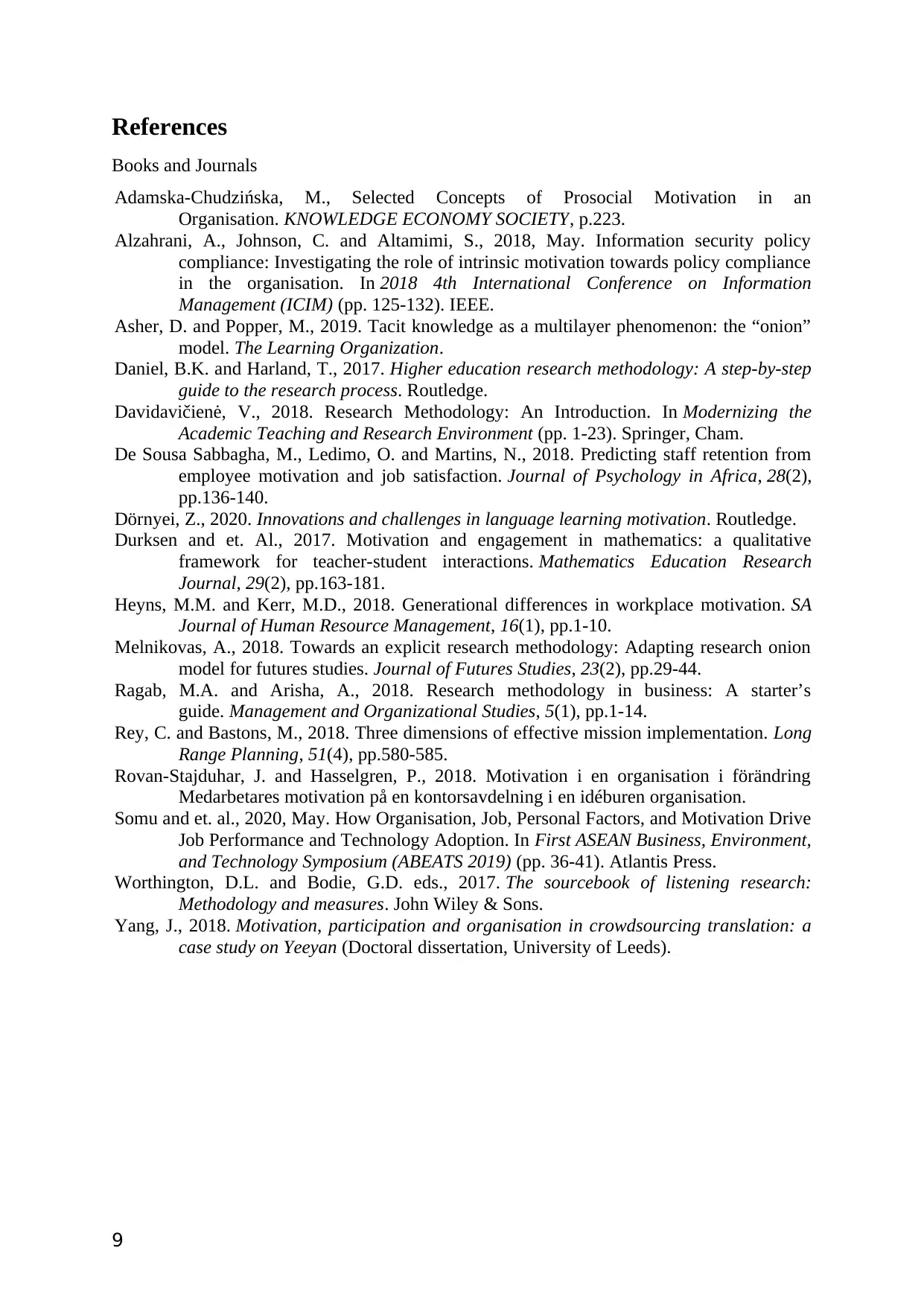
References
Books and Journals
Adamska-Chudzińska, M., Selected Concepts of Prosocial Motivation in an
Organisation. KNOWLEDGE ECONOMY SOCIETY, p.223.
Alzahrani, A., Johnson, C. and Altamimi, S., 2018, May. Information security policy
compliance: Investigating the role of intrinsic motivation towards policy compliance
in the organisation. In 2018 4th International Conference on Information
Management (ICIM) (pp. 125-132). IEEE.
Asher, D. and Popper, M., 2019. Tacit knowledge as a multilayer phenomenon: the “onion”
model. The Learning Organization.
Daniel, B.K. and Harland, T., 2017. Higher education research methodology: A step-by-step
guide to the research process. Routledge.
Davidavičienė, V., 2018. Research Methodology: An Introduction. In Modernizing the
Academic Teaching and Research Environment (pp. 1-23). Springer, Cham.
De Sousa Sabbagha, M., Ledimo, O. and Martins, N., 2018. Predicting staff retention from
employee motivation and job satisfaction. Journal of Psychology in Africa, 28(2),
pp.136-140.
Dörnyei, Z., 2020. Innovations and challenges in language learning motivation. Routledge.
Durksen and et. Al., 2017. Motivation and engagement in mathematics: a qualitative
framework for teacher-student interactions. Mathematics Education Research
Journal, 29(2), pp.163-181.
Heyns, M.M. and Kerr, M.D., 2018. Generational differences in workplace motivation. SA
Journal of Human Resource Management, 16(1), pp.1-10.
Melnikovas, A., 2018. Towards an explicit research methodology: Adapting research onion
model for futures studies. Journal of Futures Studies, 23(2), pp.29-44.
Ragab, M.A. and Arisha, A., 2018. Research methodology in business: A starter’s
guide. Management and Organizational Studies, 5(1), pp.1-14.
Rey, C. and Bastons, M., 2018. Three dimensions of effective mission implementation. Long
Range Planning, 51(4), pp.580-585.
Rovan-Stajduhar, J. and Hasselgren, P., 2018. Motivation i en organisation i förändring
Medarbetares motivation på en kontorsavdelning i en idéburen organisation.
Somu and et. al., 2020, May. How Organisation, Job, Personal Factors, and Motivation Drive
Job Performance and Technology Adoption. In First ASEAN Business, Environment,
and Technology Symposium (ABEATS 2019) (pp. 36-41). Atlantis Press.
Worthington, D.L. and Bodie, G.D. eds., 2017. The sourcebook of listening research:
Methodology and measures. John Wiley & Sons.
Yang, J., 2018. Motivation, participation and organisation in crowdsourcing translation: a
case study on Yeeyan (Doctoral dissertation, University of Leeds).
9
Books and Journals
Adamska-Chudzińska, M., Selected Concepts of Prosocial Motivation in an
Organisation. KNOWLEDGE ECONOMY SOCIETY, p.223.
Alzahrani, A., Johnson, C. and Altamimi, S., 2018, May. Information security policy
compliance: Investigating the role of intrinsic motivation towards policy compliance
in the organisation. In 2018 4th International Conference on Information
Management (ICIM) (pp. 125-132). IEEE.
Asher, D. and Popper, M., 2019. Tacit knowledge as a multilayer phenomenon: the “onion”
model. The Learning Organization.
Daniel, B.K. and Harland, T., 2017. Higher education research methodology: A step-by-step
guide to the research process. Routledge.
Davidavičienė, V., 2018. Research Methodology: An Introduction. In Modernizing the
Academic Teaching and Research Environment (pp. 1-23). Springer, Cham.
De Sousa Sabbagha, M., Ledimo, O. and Martins, N., 2018. Predicting staff retention from
employee motivation and job satisfaction. Journal of Psychology in Africa, 28(2),
pp.136-140.
Dörnyei, Z., 2020. Innovations and challenges in language learning motivation. Routledge.
Durksen and et. Al., 2017. Motivation and engagement in mathematics: a qualitative
framework for teacher-student interactions. Mathematics Education Research
Journal, 29(2), pp.163-181.
Heyns, M.M. and Kerr, M.D., 2018. Generational differences in workplace motivation. SA
Journal of Human Resource Management, 16(1), pp.1-10.
Melnikovas, A., 2018. Towards an explicit research methodology: Adapting research onion
model for futures studies. Journal of Futures Studies, 23(2), pp.29-44.
Ragab, M.A. and Arisha, A., 2018. Research methodology in business: A starter’s
guide. Management and Organizational Studies, 5(1), pp.1-14.
Rey, C. and Bastons, M., 2018. Three dimensions of effective mission implementation. Long
Range Planning, 51(4), pp.580-585.
Rovan-Stajduhar, J. and Hasselgren, P., 2018. Motivation i en organisation i förändring
Medarbetares motivation på en kontorsavdelning i en idéburen organisation.
Somu and et. al., 2020, May. How Organisation, Job, Personal Factors, and Motivation Drive
Job Performance and Technology Adoption. In First ASEAN Business, Environment,
and Technology Symposium (ABEATS 2019) (pp. 36-41). Atlantis Press.
Worthington, D.L. and Bodie, G.D. eds., 2017. The sourcebook of listening research:
Methodology and measures. John Wiley & Sons.
Yang, J., 2018. Motivation, participation and organisation in crowdsourcing translation: a
case study on Yeeyan (Doctoral dissertation, University of Leeds).
9
⊘ This is a preview!⊘
Do you want full access?
Subscribe today to unlock all pages.

Trusted by 1+ million students worldwide
1 out of 9
Related Documents
Your All-in-One AI-Powered Toolkit for Academic Success.
+13062052269
info@desklib.com
Available 24*7 on WhatsApp / Email
![[object Object]](/_next/static/media/star-bottom.7253800d.svg)
Unlock your academic potential
Copyright © 2020–2025 A2Z Services. All Rights Reserved. Developed and managed by ZUCOL.





